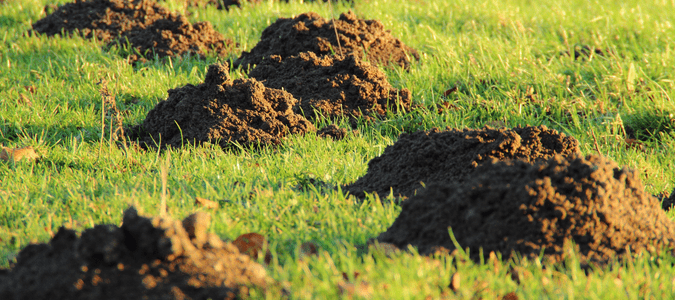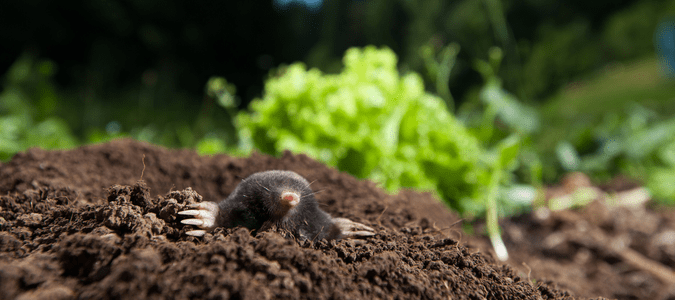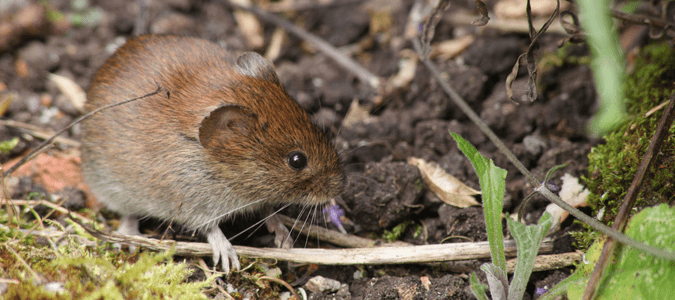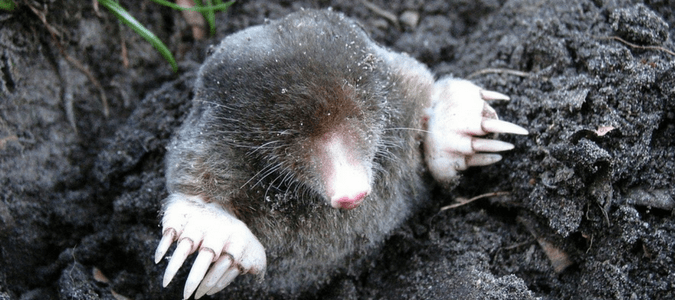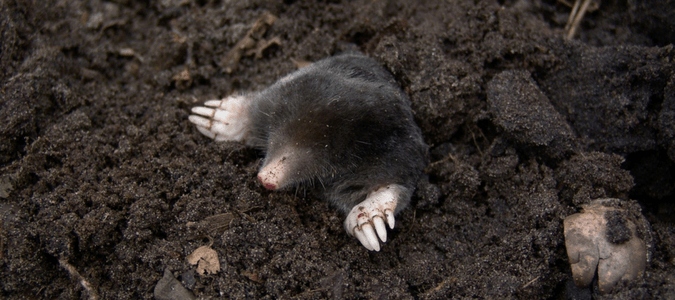Mole Identification
Moles grow to an average length of 4 to 7 inches, and have paddle-shaped hind feet and disproportionately large digging claws. Their elongated head features very small eyes and ears that are not externally visible. The mole’s body is covered in a pelt of smooth, brownish-black fur which has no grain. This unique feature allows them to move through their tunnels with very little friction.
Moles can dig at an incredible rate, nearly twenty feet each hour, adding as much as 150 feet to their tunnels each day. As they dig, moles will eat as the opportunity presents itself, consuming up to 100% of their own body weight in worms, insects and grubs as they go. For a 5-ounce mole, that equates to 50 pounds of prey each year.
Some, like the star-nosed mole, are also accomplished swimmers, adding small fish and aquatic invertebrates to their diet as well.
Most moles are active early in the morning and late in the evening, especially on overcast days in the spring or fall. Meadows, grassland, woodlands, wetlands and riparian areas are the mole’s preferred habitats. However, some species, like the desert shrew, prefer to live in more arid regions.
Breeding occurs in the early spring, and males will tunnel outside of their regular areas in search of female partners. The female’s gestation period lasts about seven weeks, producing 3 to 5 pups in a litter, typically in late March or April. The pups will begin hunting for their own food at around 3 weeks old, and can be ready to leave the nest and live on their own in just 30 to 45 days.
When it comes to controlling these creatures, one option is to poison them, but poison is not an effective or safe choice. Mole poisons are typically designed to be left inside active mole tunnels. However, these locations are usually near molehills or other openings where they can easily be reached, posing a hazard to children, pets and wildlife.
In rainy areas, poison baits can also be washed into nearby water sources, contaminating water habitats for significant distances downstream.
Trapping is one of the most efficient ways to get rid of moles in your yard, but these can also present dangers due to their accessibility. Snap traps, scissors traps and empaling traps are the most common types used and are especially effective in the fall and winter months. However, these traps also require a level of expertise to be successful, and correct placement is critical. Moles have an extremely keen sense of smell and will avoid traps that smell of humans or other unfamiliar odors.
The good news is that, since moles tend to live a fairly solitary lifestyle, and will ferociously defend their tunnels and territory, there are usually only a few of them to deal with within a given area.
Moles also attract mole predators, who are also in search of an easy meal. Weasels, coyotes, foxes, and even feral dogs and cats can create massive amounts of damage trying to dig moles out of the protection of their tunnels. Snakes can be attracted to areas with an ongoing mole population, as well.
Vole Identification
Despite the similarities in their names, voles are very different from moles, both in appearance and behavior. Voles are actually a type of mouse. Similar in appearance to field mice, but with blunt noses, and very short tails, voles have a small, heavy frame, small eyes and barely visible ears. Their fur tends to come in shades of grey or brown.
Growing to an average of 6 inches long (including their tails), voles boast long, sharp teeth for chewing through roots and plant stems. Fully grown, voles weigh about 2 ounces, and have a lifespan of up to 1 year.
On rare occasions, voles will eat insects or snails, but most of the time their diet is purely vegetarian, preferring grass, seeds, roots, plant stems and plant leaves.
23 species of voles are native to the United States, with many more species inhabiting the rest of the northern hemisphere. Unlike moles, voles are active all throughout the year, both day and night. They don’t hibernate in winter.
Voles are far more prolific breeders than moles, producing young throughout the entire year. In fact, they are one of the most prolific breeder species in the rodent family, producing up to 10 litters each year, with 3 to 6 pups per litter. That equates to a possible 60 offspring in each female’s relatively short lifetime.
Voles seldom range outside of a quarter acre area, and thrive in a wide variety of habitats, as long as they provide dense ground cover. Like moles, they spend most of their lives underground in tunnels where they hide from predators, nest and feed on the roots of plants.
Unlike moles, voles live as part of colonies, and their nests can be as large as 40 feet in diameter and house up to a dozen family members including two adults, several juveniles and a half-dozen babies.
Voles will occasionally inhabit abandoned mole burrows, as well, digging golf-ball-sized exit holes in new locations of the tunnels.
One of the most effective ways of controlling vole populations is through habitat modification, which means reducing or eliminating their sources of food and shelter.
The most efficient way to control these creatures is by contacting a specialist. They will be able to identify which creature you are dealing with and then create an effective plan for getting rid of them.
Do Moles Carry Rabies?
Both moles and voles are carriers of parasites and infectious diseases. In rare cases, these pests can carry transmittable diseases like rabies.
But, for the most part, it’s the ticks, fleas and other parasites that they carry around with them that present the real danger. Ticks can transmit Spotted Fever, Tularemia, Lyme disease and Rocky Mountain spotted fever, just to name a few. Other parasites, like tapeworms or Bartonella, can also be passed from both fleas and ticks to humans and their pets, by touching the host’s bodies, or even just walking through piles of leaves or tall grasses within their habitat.
How Deep Do Moles Dig?
While surface tunnels are usually just an inch or two below the soil, or even break the surface in places, moles create deeper runways up to a foot underground that connects their nests to the surface tunnels. Though out of sight, these deeper runways can result in significant instability and damage to the foundations of homes and other structures.
Home and property owners who are tired of dealing with these burrowing pests, and the havoc they leave behind, should invest in professional help.
The most efficient plan of attack is to contact a professional pest control service, as they have the training, experience and equipment to identify primary tunnels and nesting areas, and have the ability to control critters efficiently and effectively.
When controlling rodents on your property it’s best to keep the project short and simple. A professional can assess your specific situation, and then offer you tested and proven pest control options that are customized to fit your personal needs.
ABC Can Get Rid of Pests
Whether you’re dealing moles or voles, it can be time-consuming and frustrating. Instead of trying to get rid of moles on your own, contact ABC Home & Commercial Services. Our professionals will create a customized control plan, so you can enjoy your yard.
